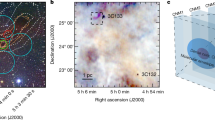Abstract
We extend earlier work by Charnleyet al. (1990) on the diagnosis of boundary layers between dark molecular cores and ionized stellar winds by including the effect of magnetic pressure on boundary layer structure, adding a description of the chemistry of simple nitrogen bearing species, and adopting chemical initial conditions that are similar to those observed to obtain in the TMC-1 dark core as well as (for other models) low depletion equilibrium chemical initial conditions. The observational detection of CI emission concentrated in a boundary layer would provide the most direct indication that mixing between ions and neutrals occurs in boundary layers; the very high C0 fractional abundances and high H2 number densities that are probably required for the detection of CI emission obtain only if in the underlying core the total pressure is at least about 10−10 erg cm−3 and the rate at which stellar wind ions are mixed into the boundary layer is in the high range of what Charnleyet al. (1990) estimated to be reasonable. CH, OH, and H2O fractional abundances respond sensitively to the heating rate in the boundary layer. In many cases molecular ions including HCO+, HCS+, and N2H+ should have elevated fractional abundances in the boundary layers even if no mixing occurs. The boundary layer fractional abundances of C2, C2H, CN, and HCN (and probably of cyanopolyynes which were not included in the chemical models) are very sensitive to the assumed depletions and in models with high heating and mixing rates and low depletions are very high relative to their dark core fractional abundances.
Similar content being viewed by others
References
Charnley, S.B., Dyson, J.E., Hartquist, T.W. and Williams, D.A.: 1990,Monthly Not. Roy. Astr. Soc. 243, 405.
Chièze, J.P. and Pineau des Forêts, G.: 1990,Astron. Astrophys. 221, 89.
Chièze, J.P. Pineau des Forêts, G. and Herbst, E.: 1991,Astron. Astrophys. 373, 110.
Crutcher, R.M., Mouschovias, T.Ch., Troland, T.H. and Ciolek, G.E.: 1994,Astrophys. J., (submitted).
Draine, B.T., Roberge, W.G. and Dalgarno, A.: 1983,Astrophys. J. 264, 485.
Hartigan, P., Morse, J.A., Heathcote, S. and Cecil, G.: 1993,Astrophys. J. (Letters) 414, L121.
Hartquist, T.W. and Dyson, J.E.: 1993,Quart. J. R. Astr. Soc. 34, 57.
Myers, P.: 1990, in: T.W. Hartquist (ed.),Molecular Astrophysics -A Volume Honouring Alexander Dalgarno, Cambridge University Press, Cambridge.
Nejad, L.A.M., Hartquist, T.W. and Williams, D.A.: 1994,Astrophys. Space Sci. 220, 261.
Author information
Authors and Affiliations
Rights and permissions
About this article
Cite this article
Nejad, L.A.M., Hartquist, T.W. Chemical diagnostics of magnetized boundary layers. Astrophys Space Sci 220, 253–260 (1994). https://doi.org/10.1007/BF00658056
Received:
Accepted:
Issue Date:
DOI: https://doi.org/10.1007/BF00658056




